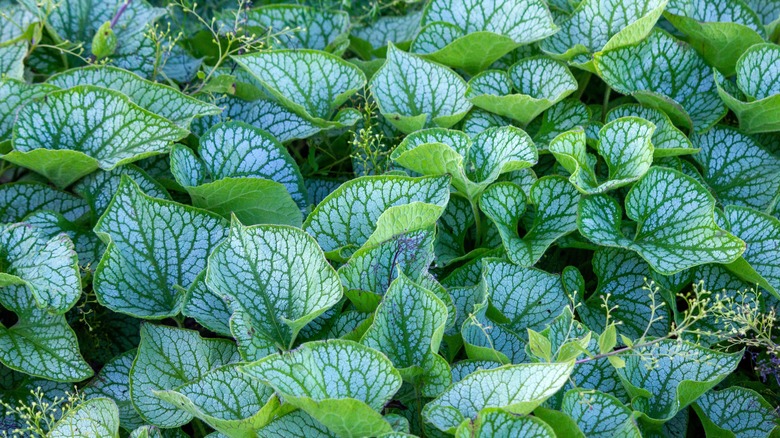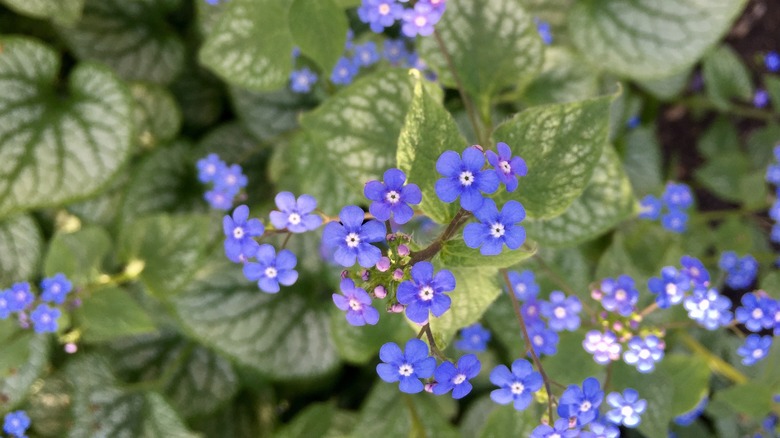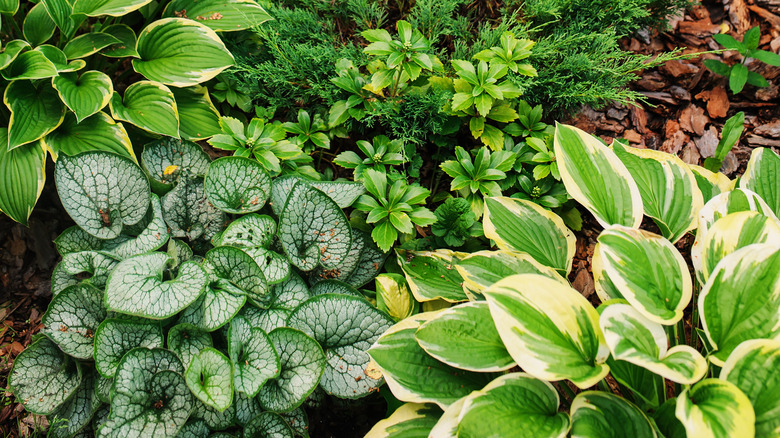This Brunnera Plant With Heart-Shaped Leaves Will Produce Adorable Blue Flowers
If you're looking for the perfect plant to add interesting color and texture to your shaded garden, then look no further. Brunnera macrophylla, also known as Jack Frost, is a true showstopper. This award-winning ground cover is a dream to grow and take care of because of the minimal effort and fuss it needs to reach its full potential. Native to Siberia and brought to the United States in the year 2000, Jack Frost boasts its nativity with its frosted, veiny leaves that resemble snow-capped trees. It might be slow to grow, but when it does, it rewards you with gorgeous ground cover you didn't know you needed.
Jack Frost quickly gained popularity among gardeners who love this plant for its resilience. This perennial is popular for its shimmering veiny blue and green heart-shaped overlapping leaves that grow in adorable and dense round 12-18 inch tall mounds that go on to produce hundreds of wonderful blue flowers that stand on thin stems. Hardy in USDA zones 3-8, brunnera prefers fertile, moist soil with well-draining soil, but it is adaptable to clay. This plant does well in partial or full shade, which makes it perfect to plant in your backyard if you have large trees that create large, cool shade that grass tends to shy away from.
How to grow brunnera plants
Brunnera macrophylla can be grown from seeds, but experts advise against it because the plants are unlikely to resemble the parent plant. Instead, it can be propagated by division of an established plant or from root cuttings. You can do this by digging up an established brunnera and removing any excess soil to allow you to get a good look at the roots. Use a sharp knife to cut off any roots that look weak or unhealthy and put them aside. Divide your roots into smaller sections depending on how many plants you want to propagate from the parent plant. Since you're sourcing your roots from an established plant, cut the leaves shorter so that the now smaller roots can withstand their weight. Around 4-6 inches should be enough.
Whether you choose to plant your roots in a container or directly into the soil, you can prepare your soil by adding a quality potting mix. If you're planting directly into the garden, dig holes that are the same depth as the established plant and place the cuttings in each hole. If you're planting in a container, make sure it has a large drainage hole at the bottom. Avoid layering the bottom of your container with rocks, as this might result in your plant sitting in too much moisture. Instead, use newspaper to keep your potting mix from draining because you'll need to water your plant generously.
How to care for your brunnera plant
Because Jack Frost is such a resilient plant, it doesn't require as much fuss as other plants might demand from their gardeners. The plant might be visited by the occasional slug that tries to feed off the dense foliage but is hardly fazed by that. Brunnera is also resistant to deer and rabbits as well as other diseases that would usually cause a headache for you in your garden. Despite its love for moist soil, the plant grows to become pest, disease, and drought-tolerant if it's kept in ideal conditions. Keep your plant happy by mulching and watering it regularly in its earlier life to maintain cool and moist soil.
Jack Frost can tolerate moderate sunlight in the more northern regions, but its foliage is likely to wilt and start yellowing if it's exposed to direct midday sun in warmer climates. Be sure to remove any unsightly or damaged foliage when you see it. The plant will require less care from gardeners as it grows, but pruning and deadheading will go a long way in preventing weeds while keeping your plant looking its best all season long. You can plant them with some spring bulbs to really put on a show when they bloom.


